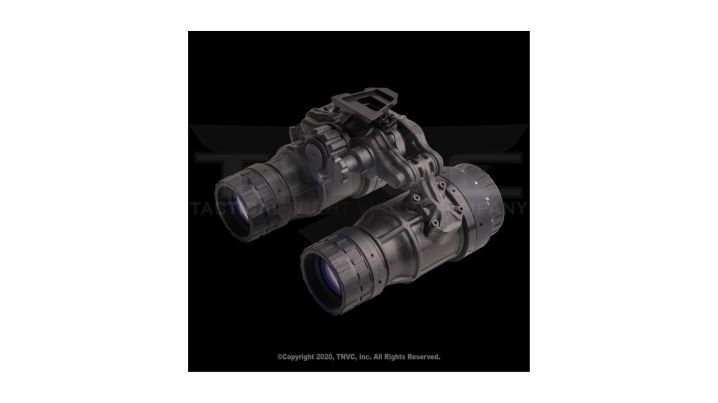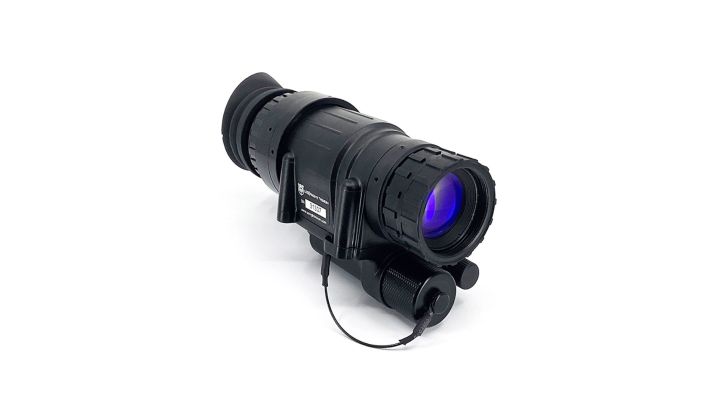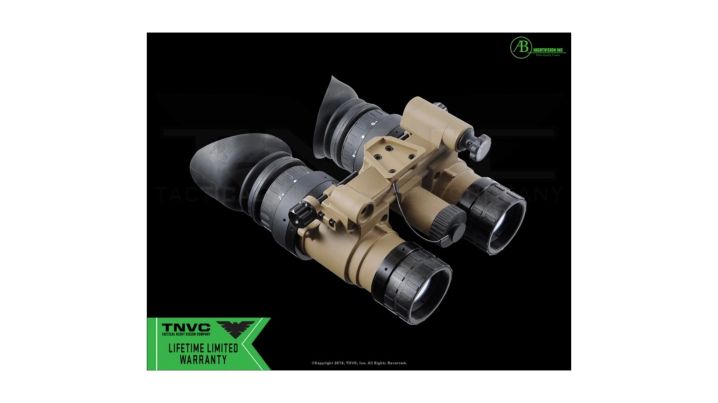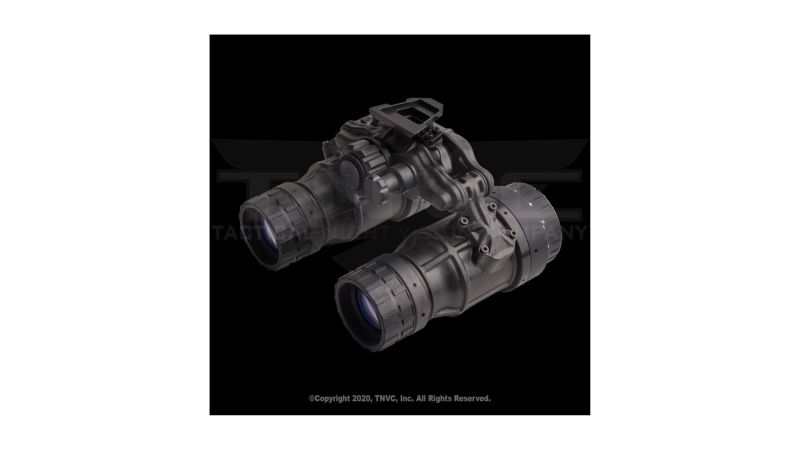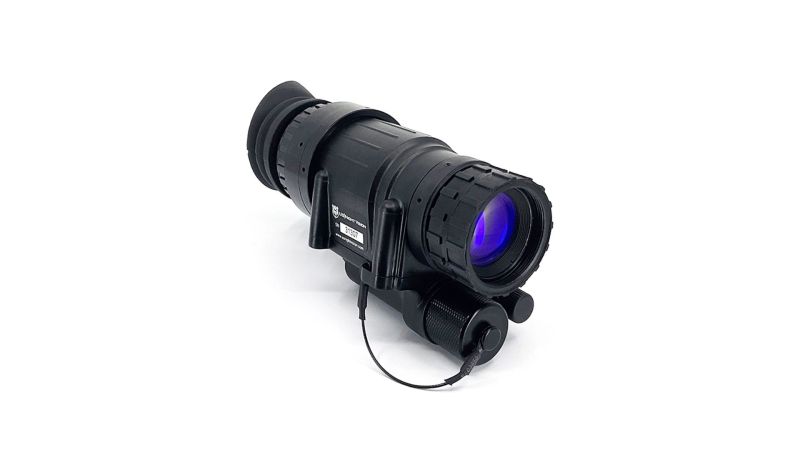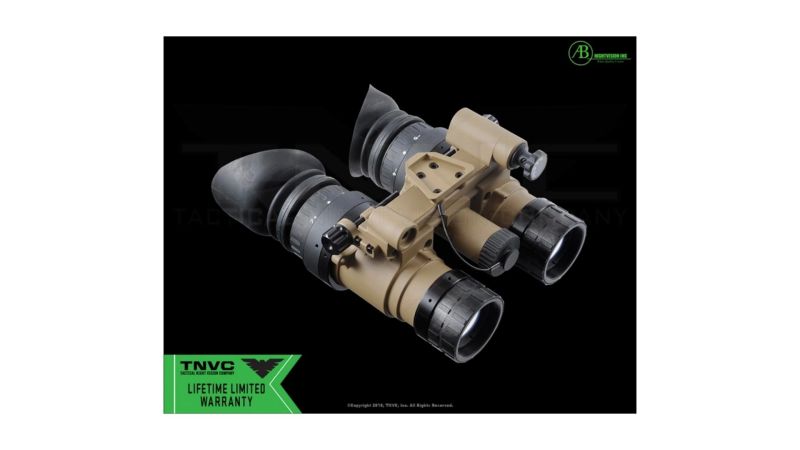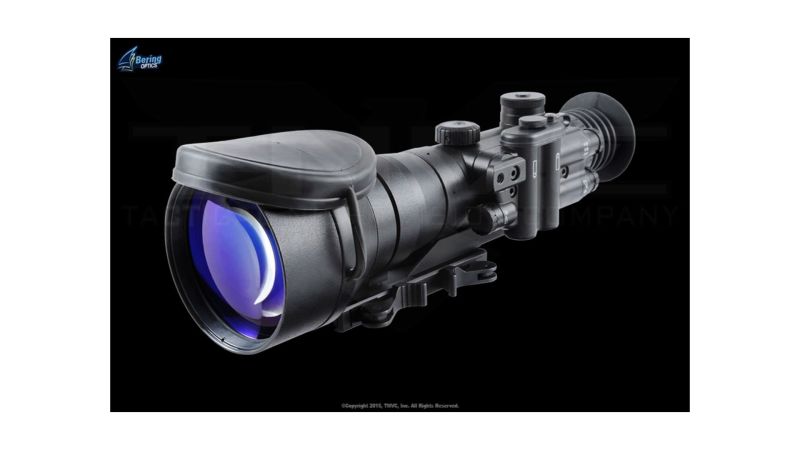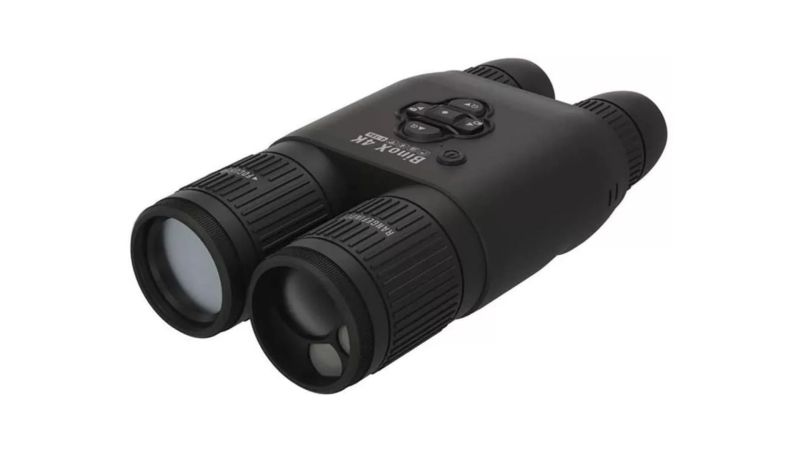We may earn revenue from the products available on this page and participate in affiliate programs.

The first time I got issued night vision in the Marine Corps, I felt like a true badass. With my trusty NVG and motivated M249, I would own the night harder than the grim reaper with insomnia. That magical little PVS-14 would unlock the darkness like a video game cheat code and leave the enemy nowhere to hide.
Except none of those things turned out to be true. My first training evolution was to simply walk a marked path through the woods, and even that proved damn near impossible. I kept tripping over roots, gouging my face on branches, and waving my arms in front of me like a cartoon mummy.
If you’re new to night vision, you should expect a similar learning curve. In addition to the challenges I faced, you’ll have to come up with a four-figure stack of dollar bills to fund the experience. But, like those before you, you’ll get the hang of it. Call it what you want — night vision, NVG, or NODS — being able to see in the dark is a total game-changer.
We know a thing or two about working with night vision and we enlisted the help of some of the industry’s best to make sure you not only know what products are available, but also what kind of information should guide your buying decision, and how to get the most out of your investment.
Best Overall
TNV Dual-Tube Night Vision System
Best Value
U.S. Night Vision PVS-14
Editor’s Pick
TNV Ruggedized Night Vision Goggle
Best Night Vision Scope
Bering Optics D760 Gladius
Best Night Vision Binoculars
ATN BinoX
Why you should trust us
Bringing you the best gear money can buy is a full-time job for the Task & Purpose crew. We’re always very careful about making recommendations involving your hard-earned money, especially when we’re dealing with a financial commitment as serious as a night vision device and everything that goes along with it. We realize that for many of you, an optic alone could be a month’s salary. On top of that, this is equipment that you could rely on to save your life at some point. That weighs heavy on us, and we take personal responsibility for bringing you only the best products out there.
Types of night vision devices
Before you start throwing money at a night vision setup, we recommend familiarizing yourself with the technology available in the context of your own needs. Augee Kim, vice president at Tactical Night Vision Company, had some good advice when we talked to him.
“Generally speaking, when we talk to customers, our advice is to balance requirements with budget,” Kim said. “While obviously everyone always wants the best, night vision is not inexpensive, and a realistic budget is very often an important factor. This advice applies to both commercial and government/law enforcement customers.
“Long story short, customers should ask themselves: ‘What do I want/need to do?’ and ‘How much can I realistically spend for these capabilities?’ To me, this is the most important and critical — and, sadly, overlooked aspect of night vision buying — so many people are dazzled by what is popular on social media, or what special operations is using, etc., and don’t think as critically about their own needs and requirements, and let that drive their purchasing decisions.
“From there, we can get into a whole lot more detail, and one of the things that TNVC excels in is consulting with individual users about their requirements and what products are available to meet those requirements within their budget and being able to provide a tailored solution to meet their needs.”
Helmet-mounted night vision devices
The vast majority of night vision devices will end up on a helmet. We say helmet-mounted rather than head-mounted because strapping a device to your head just isn’t stable enough for real-world use. Even if you don’t spend big bucks on a ballistic helmet, having a rigid, stable foundation will make all the difference.
The interface between your helmet and night vision device starts with the hard shroud that will mount directly to the front of your helmet. Think of it as a low-profile quick release. That’s where you’ll clip in your mounting system. Finally, an arm will attach to your NVG. If you want to make things easy and cost-effective, U.S. Night Vision has packaged everything you need (including a laser) at a heavy discount right here. All that gear is fairly heavy, so some people like to add ballast weight (or better yet, a remote battery) to the back of their helmet to balance the load. It’s heavier that way, but at least the force is coming straight down and not yanking your face toward the deck.
It’s a lot of information to take in. Planning out the right setup for you will take time and it’s important to get it right. Once you’re done, you can buy with confidence knowing that you have quality gear that’s backed by a warranty and will come through for you when you need it most.
Handheld night vision devices
Going handheld is by far the cheapest way to enter the night vision arena. If you want to see in the dark without role-playing your favorite YouTube operator, you can get by with a basic digital night vision monocular or binoculars like the ATN BinoX.
These devices are not compatible with weapons, so nights at your local shooting range are out of the question unless you just want to creep from the peanut gallery. They’re also lousy for moving, so get used to being in a static position. If you’re good with those drawbacks, you can absolutely use these devices to observe your surroundings. They can be very useful for hunters who sit in a hide and scan for predators or hogs until it’s time to switch to the next type of night vision device on our list.
Night vision scopes
You would-be Ricky Recons out there might be wondering to yourself, “If all I want to do is shoot in the dark, why do I need all this high-speed mobile gear?” The answer is that you don’t. Plenty of hunters set up and call in predators at night, and they’re taking (relatively) known-distance shots from a static position. Oftentimes, they’re reaching out far beyond what anyone with NODS and a laser would attempt.
What you need in that kind of situation is a night vision scope. Something like the Bering Optics D760 Gladius can provide a six-power magnified, illuminated image. That’s enough power to make precision shots at serious distances for nighttime shooting. Another option is to pair a clip-on night vision device like the Knight’s Armament UNS-A3 with your existing, compatible optic.
Key features of night vision devices
Analog vs. digital
Digital night vision is improving in leaps and bounds, but it hasn’t earned the same wide acceptance as analog night vision. They work just like a mirrorless digital camera, meaning a sensor creates an image that you see on a screen. The quality of the sensor and screen both present bottlenecks that limit the quality of the image you see. There can also be noticeable lag that’s obviously not great. On the plus side, digital night vision devices allow you to overlay GPS information and record photos and video. They’re often less expensive than analog alternatives, but we’d still prefer the old-school tech for now. T.Rex Arms has a fantastic breakdown of the differences if you want to really nerd out.
Monocular vs. binocular
Most people end up buying a single-tube night vision device out of financial necessity. Options like the PVS-14 have been around for decades and used examples are readily available (more on that in the pricing section). Like many other service members, this is what I used back in the day. Which eye you use is situation-dependent and personal preference, so see what works best for you. Your best bet is to buy a mount that can be flipped from side to side so you can switch on the go. Either way, training is necessary because your depth perception is going right out the window without substantial ambient light, and you’re going to feel like a drunk in a house of mirrors at first.
Binocular night vision devices solve this problem by giving each eye a bright, clear view of the world around you. As a result, you’ll experience depth perception that lets you move much more naturally — hence, the significant jump in price. Because the two tubes are (typically) mounted parallel with a high degree of overlap, the field of view isn’t noticeably improved over what you get from a monocular. There are also (extremely expensive) quad-tube setups available if you want a wider field of view. Just be aware that they’re also significantly heavier.
The staff at TNVC recommend upgrading to binocular units when possible, especially as the complexity of your operations increases.
“Binocular units offer superior depth perception as well as binocular summation which can aid in detection, and being more natural to use, they can have a psychological effect that allows users to remain more clear-headed in high-stress scenarios and complex environments,” Kim said. “This is not to say that these things can’t be done with a monocular — they can — but in many cases, a binocular will be better and easier.”
We should point out that it’s possible to create your own setup with a bridge and two monoculars, but that’s a bit like welding two motorcycles together and calling the result a car. Because it’s difficult to precisely calibrate the tubes to each other, you’ll likely experience dizziness and headaches in short order. Basically, your eyes will be giving your brain conflicting information and the poor thing is just going to short-circuit until your stomach offers your most recent meal as tribute.
Green vs. white phosphor
When you picture what night vision looks like, you’re probably imagining a world of green and black hues. That’s because green phosphor has been around for decades and it’s what we’re used to. It works, it’s easy on the eyes, and it’s readily available.
Some newer devices come with white phosphor, which actually produces a slightly blue tint. Some people prefer this style because it creates less eye strain and they feel like they see better with it. If you’re one of those people, by all means, buy white phosphor. The color is ultimately far less important than the technology behind it, so buy the most recent generation of night vision you can afford and then prioritize color.
Generation 1, 2, 3, and 4 technology
Gen 1: In the beginning, there was only darkness (and the bodies of people who ran around the battlefield with flashlights). The first night vision technology saw action as early as the 1930s — but not in the way you think.
“Photocathodes were used for way more than night vision,” Isaac Botkin said in a video for T. Rex Arms. “They’re how every video camera ever worked at the very beginning of the early days of television.”
This technology was used during World War II and the Korean War, but it wasn’t until the U.S. began fighting in Vietnam that Gen 1 night vision came into play.
Inside the tube of a Gen 1 night vision device is a photocathode that converts visible and infrared photons into electrons. A phosphor then causes all of those electrons to glow, creating a visible image that combines the power of the visible and infrared spectrums. To be effective, these systems needed infrared illumination to work in the absence of adequate ambient light.
Gen 2: During the 1970s, night vision technology saw the addition of a microchannel plate that multiplied the incoming electrons. This resulted in a much brighter image that could be used without an IR light. Since carrying around an IR searchlight was no longer required, night vision became a much more viable option for military use.
Gen 3: Improved photocathodes developed in the 1980s brought about the third generation of night vision devices. Individual components are more effective, allowing each stage of the process to be executed with greater efficiency and compounding results. The bad news is that, since the birth of Gen 3 night vision, technological improvements have gotten progressively smaller. What we’re using today is very similar to what was available 40 years ago, and the founding principles are about a century old.
Gen 4: It’s not a thing. It is fake news. During the 1990s, the U.S. Army experimented with upgrades that appeared to be the next step in night vision technology, but high failure rates ultimately spelled the doom of Gen 4 night vision for the time being. Anyone trying to sell you a Gen 4 night vision device is probably referring to high-end Gen 3, and a bit of skepticism is justified.
Digital night vision: What isn’t fake is digital night vision. This approach uses the same sensors found in digital cameras to provide an image on a tiny screen inside the eyepiece. There are advantages and disadvantages but, in most real-world scenarios, digital night vision devices are not able to compete with analog alternatives right now. We expect this technology to have its heyday, but it isn’t here quite yet.
Other considerations
You know what we call a high-dollar night vision device that flops around when you’re trying to use it? Useless. Before you blow your budget on night vision, make a shopping list that includes not only the device, but also the mount, helmet, and accessories like a battery pack or counterweight. More adjustability is always better, so don’t cheap out on this stuff. And always dummy cord everything to everything else.
Garand Thumb has a nice breakdown of the basics, so give his video a look.
Benefits of night vision devices
Night ops
Everybody buys night vision devices for the same reason: to own the night. Reality is probably closer to a lease on a 40-degree section of the night for the lifespan of your battery, but we appreciate the enthusiasm. With enough practice, you can absolutely turn darkness into a huge tactical advantage. There’s a reason night vision capability was considered one of the biggest disparities between U.S. and Iraqi forces during the Gulf War.
As always, there is a big difference between having night vision and having night vision capability. We’d rather work alongside people who have basic monoculars and thousands of hours of training than people who pulled the latest and greatest quad tubes out of the box an hour ago.
Integration with your weapon system
We’re willing to go out on a limb and assume that you aren’t interested in night vision because you want to sit in the dark and watch the mushrooms grow. No, you probably have tabs open for night vision, an IR laser, and some kind of compatible red dot right now. The good news is that night vision can be integrated into your weapon system extremely effectively.
Your first option is a passive setup. With this method, you’ll sight in with your optic just like you normally would, except with a night vision device between your dominant eye and the optic itself. Lining the two up can be tricky, so you’ll need to practice. This approach also leaves you with an extremely limited field of view, so your situational awareness will take a big hit any time you go to sights. Finally, make sure that any kind of electronic optic is compatible with night vision (like these). A red dot that’s too bright will blow out your view the same as looking directly into a flashlight would.
Most people prefer active setups. This approach replaces your daytime optic with an infrared laser like the military’s PEQ-15 or civilian options like the L3Harris ATPIAL-C and Steiner OTAL. Instead of looking through your sights, you can just shoulder your weapon, keep your head upright, and place the (visible to you) laser on the target. This method also takes practice, but is generally much faster in execution and relatively easy to learn.
Another option is mounting your night vision directly to your rifle in the form of a night vision scope or clip-on night vision. These are great for stationary shooters who need to shoot longer distances. This type of setup is popular with predator hunters, hog hunters, and designated marksmen.
Teamwork makes the dream work
Using any kind of night vision device takes practice. Using it with a weapon takes even more. Using it as part of a team is a continuous process. If you and a few buddies plan on taking on the zombie apocalypse as a unit, you’d better get some hands-on training before the undead sprout from the ground. Can you all function independently? Can you move as one? Can you use your equipment to communicate effectively? Keep coming up with questions and exercises to test yourselves.
One advantage of teamwork is being able to spread the cost. We recommend helmet-mounted night vision over weapon-mounted devices, but if you work as a team, there’s no reason you can’t designate one person with an SPR, DMR, or bolt rifle to be your distance shooter with a weapon-mounted setup. While the rest of you move with your monocular or binocular mounted rigs, that person can provide overwatch from a stationary position that takes advantage of their device’s unique capabilities.
There’s a great scene in “13 Hours: The Secret Soldiers of Benghazi” that illustrates how members of a team can use night vision to understand a rapidly changing situation, communicate what they see, identify targets, and use the darkness to their advantage. The possibilities are endless, so work together to find what works for your group. Then practice until it’s boring.
Knowing what the hell you’re doing
Of course, you can only take advantage of all these benefits if you train with your equipment. Swiping your credit card and putting NODS in the closet doesn’t give you ownership of the dark. In our conversation with Kim, he drove this point home and offered some great pointers.
“I always recommend some sort of professional training with experienced end-users,” he said. “We at TNVC have an in-house Training & Education division and provide both open and closed enrollment classes, and we are one of, if not the only entity that can assist users from having no night vision knowledge whatsoever to generating requirements, product selection, lifecycle support, and basic and advanced training to create operational capability — all under one roof. However, there are many companies that provide good training.
“While ‘Get professional training’ is a common refrain in our industry, for night vision specifically I think it can be hugely important and help reduce the learning curve. As I’ve alluded to, there’s a lot of information as well as misinformation out there, and the reality is that many people have limited exposure to the technology and equipment prior to purchasing. Professional training can help kickstart your learning and give you a much better baseline than trying to go it alone by trial and error. As a matter of fact, our training program not only offers rental equipment, but we also have a Try Before You Buy program which we often encourage people to attend before they make purchasing decisions to allow them to be better informed about their needs.
“In terms of non-professional training, one of the big things I would recommend is to get accustomed to doing things by feel and without looking at them — night vision is an awesome capability, but one of its limitations is the fixed focus — unlike our eyes, night vision does not allow you to quickly switch between near and far focus, which in practice tends to mean that anything within about six feet will be blurry and out of focus.
“This means you need to be able to do things like weapon manipulation, magazine changes, and activating (and, if applicable, mode-switching) on accessories like lights and lasers largely by feel rather than sight. But it also involves more simple and mundane tasks like tying shoes, eating and drinking food, and opening doors. In our training classes, often one of the biggest takeaways for students is how little they’ve realized how dependent on sight they’ve been.
“A good little exercise I recommend is kicking a ball against a wall (slowly, of course), which again, seems simple, but is great skill-building. You will be able to see the ball move in and out of focus as it gets farther and nearer. It will develop your depth perception as well as your hand/eye (goggle) coordination, working within the limited field of view, etc., as you try to connect with the ball and learn to judge, and — in many cases — re-learn some skills you tend to take for granted during the day with your natural vision.”
Pricing considerations for night vision devices
Budget
Most of the products we recommend cost more than $3,000, but there are cheaper options available. These are often used, blemished, or come from questionable sources. As tempting as it may be to pay half price, that may not actually save you money. Reputable sellers like TNVC and U.S. Night Vision have frequent encounters with people who learned that the hard way.
“Just recently, we received a unit that a customer had purchased used under the belief that the image intensifier tubes were one thing, however when we received it and opened it up to do some repairs, we found that the tubes were not what had been advertised,” Kim said. “That’s a common story. Beyond that, in many cases, you have no idea of the level of skill of the builder, the source of the parts, if they’re the right parts, or even if they are using all of the parts in some cases — it’s happened, we’ve seen it all. Finally, with a reputable vendor, you usually get access to some sort of warranty or after-purchase support that is unlikely from an anonymous eBay source. At TNVC and Night Goggles we have a Lifetime Limited Warranty on all of our TNV and NGI branded systems.”
If you have your heart set on night vision but don’t have tactical applications in mind (or at least as your primary motivation), a set of handheld binoculars like the ATN BinoX can be a good solution. You’ll gain the ability to see in the dark, but forego mobility and integration with your weapon system. Discounted units like the PVS-14 we found at U.S. Night Vision are also an option.
Mid-range
This is generally where we recommend doing your shopping. Is it possible to spend less? Absolutely, but the practical utility of those products is fairly limited and if you’re investing in night vision, you’re probably pairing it with a rifle, body armor, and other equipment that you’d use in situations where saving money isn’t exactly your top priority.
At the bottom of this price range, you’ll be shopping the used third-generation PVS-14 market. Quality and prices can vary wildly, so be very diligent in doing your homework so you know what you’re getting and why it’s priced the way it is. Expect blemishes and degradation that come from years of use at the hands of people who didn’t pay for it and may not have the most thorough understanding of the equipment.
Spending $3,000 or more will open up the world of quality, new night vision monoculars. This is where you can find new PVS-14s and products like the TNV Mod3 Bravo, which is intended to be used in a dual-tube setup but can be purchased individually as a monocular.
Premium
The latest technology and features all cost north of $5,000 and prices escalate drastically. A solid set of binocular night vision goggles will run you anywhere from $7,000 to $14,000. If you want to see the world through four tubes like the very highest-speed and lowest-drag operators, you’ll need to shell out more than $40,000 and wait several months for fulfillment.
As a general rule, you should match your equipment to the task at hand. If you’re hunting coyotes or hogs on your farm, fancy binocular NODS are probably more of a want than a need. If you’re outfitting a military or law enforcement team in preparation for kinetic environments, it’s worth stepping up to more advanced equipment.
How we chose our top picks
This gear guide was a serious undertaking, so we started by circling the wagons and combining our collective knowledge. We drew from collective experience in the military, law enforcement, firearms sales, and firearms journalism. We consulted leading experts to get a better understanding of what goes into night vision technology and how customers can be best served by various products. Of course, we also binge the same videos and articles you do. The resulting list is a selection of night vision products that knock value and performance out of the park. There are no knock-offs, questionable tubes, or too-good-to-be-true imitators here; just night vision devices we’d personally trust our lives to in the darkest hour. All of them feature third-generation or digital technology and are backed by a solid warranty.
FAQs about night vision devices
You’ve got questions, Task & Purpose has answers.
Q: What’s the best inexpensive night vision?
A: We hate to break it to you, but the PVS-14 we recommended is affordable night vision. Cheap night vision might technically allow you to see in certain low-light situations, but it isn’t usable in any kind of training or tactical environment.
Q: What is the difference between night vision goggles and night vision binoculars?
A: Binocular night vision goggles mount to a helmet and use one tube for each eye to create lifelike depth perception and field of view. Night vision binoculars are devices that are used by hand rather than mounted to a helmet. The latter are often capable of magnification similar to traditional binoculars.
Q: What kind of night vision does the military use?
A: The PVS-14 is widely used by the U.S. military and NATO forces. Jobs that require enhanced night vision capabilities (think pilots, special forces, and the like) use binocular night vision goggles that allow depth perception, a wider field of view, and better image quality. The next generation of night vision technology looks like something out of a science fiction movie.
